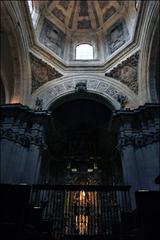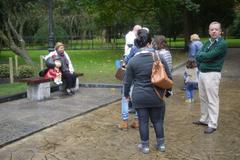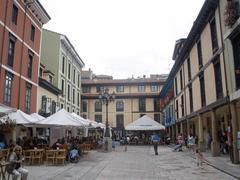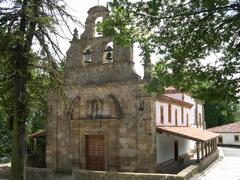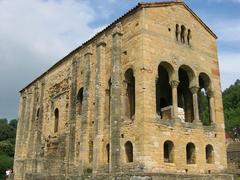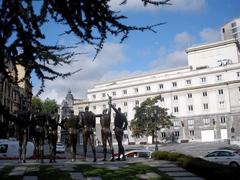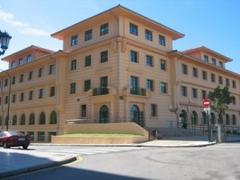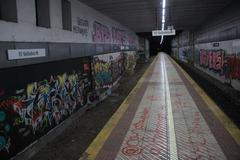
Aida Lafuente Penaos Visiting Hours, Tickets, and Oviedo Historical Sites Guide
Date: 04/07/2025
Introduction
The Aida Lafuente monument in Oviedo stands as a powerful tribute to a young activist whose bravery and political commitment during the Asturian Uprising of 1934 left an indelible mark on Asturias’ and Spain’s history. Aida de la Fuente Penaos, known as Aida Lafuente, is remembered not only for her personal sacrifice at the age of 19 but also as a symbol of youth, feminism, and resistance within the broader social and political struggles of early 20th-century Spain. This comprehensive guide explores the historical context and significance of her memorial, provides up-to-date visitor information, and suggests ways to connect with Oviedo’s rich historical and cultural heritage (Kiddle: Aida Lafuente; Wikipedia: Aida Lafuente; Oviedo Sculpture Guide).
Table of Contents
- Early Life and Family Background
- Political Climate in Early 20th Century Spain
- Aida Lafuente’s Activism and the 1934 Asturias Uprising
- The Aida Lafuente Monument: History, Design, and Symbolism
- Visitor Information: Hours, Accessibility, and Tours
- Nearby Oviedo Attractions
- Cultural Impact and Memorialization
- Frequently Asked Questions (FAQ)
- Summary and Visitor Tips
- References
Early Life and Family Background
Aida de la Fuente Penaos was born on February 25, 1915, in León, Spain, into a family deeply engaged in both artistic and political spheres. Her father, Gustavo de la Fuente, worked as a painter for the Campoamor Theater in Oviedo and was a founding member of the Communist Party of Spain in the city. The family’s commitment to social justice and political activism profoundly influenced Aida’s upbringing, fostering her early involvement in leftist causes alongside her mother, Jesusa Penaos, and her siblings (Kiddle: Aida Lafuente).
Political Climate in Early 20th Century Spain
The early 20th century was a period of intense upheaval in Spain, marked by deep divisions between conservative and progressive forces. The establishment of the Second Spanish Republic in 1931 brought reforms but also intensified social and political conflict. Asturias, with its concentration of miners and strong labor movements, became a focal point for socialist and communist activism, laying the groundwork for the 1934 uprising (Kiddle: Aida Lafuente).
Aida Lafuente’s Activism and the 1934 Asturias Uprising
As a committed member of the Communist Youth of Spain (Juventudes Comunistas de España), Aida Lafuente organized meetings, distributed literature, and advocated for workers’ rights. Her activism was part of a broader youth movement that played a significant role in mobilizing Asturias’ industrial communities.
In October 1934, the Asturias Uprising erupted as miners and workers revolted against the conservative government’s policies. The response was a harsh military crackdown, resulting in thousands of casualties. On October 13, 1934, Aida was killed in Oviedo, becoming a martyr for the cause of social justice (Kiddle: Aida Lafuente; Wikipedia: Aida Lafuente).
The Aida Lafuente Monument: History, Design, and Symbolism
Location and Creation
The Monument to Aida Lafuente stands in Parque de San Pedro de los Arcos, on Oviedo’s western edge—a site near where she lost her life during the uprising. The park’s main avenue was renamed Paseo de Aida Lafuente in 1995 by the Oviedo City Council (Oviedo Sculpture Guide). The monument, created by Félix Alonso Arena and installed in 1997 through public subscription, features a stone monolith with a bronze map of Asturias and a medallion bearing Aida’s likeness, inscribed with “Revolución de Octubre de 1934.”
Symbolism
The memorial honors both Aida as an individual and the broader struggle for social justice in Asturias. Known as the “Rosa Roja” (Red Rose) of Asturias, Aida’s image became central to Republican iconography during the Spanish Civil War, further cementing her status as a symbol of resistance and youth activism (Wikipedia: Aida Lafuente).
Visitor Information: Hours, Accessibility, and Tours
Visiting Hours and Tickets
- Open Access: The monument is in a public park and is accessible year-round, 24 hours a day. There are no entrance fees or tickets required.
Accessibility
- Wheelchair Access: The park and monument area are wheelchair accessible, with paved paths and nearby amenities.
Guided Tours and Events
- Guided Tours: While there are no dedicated guided tours for the monument itself, it is included in some broader historical and cultural tours of Oviedo. Local tourism offices and the Audiala app can provide up-to-date information on available tours.
- Commemorative Events: Annual ceremonies take place in October, particularly around the anniversary of the Asturian Revolution, featuring wreath-laying and educational activities (Visit Sights: Oviedo Tour).
Nearby Oviedo Attractions
- Campoamor Theater: Where Aida’s father worked and a landmark of Oviedo’s cultural history.
- Cathedral of San Salvador: A UNESCO-listed Gothic cathedral in the old town.
- Campo de San Francisco: Oviedo’s largest park, filled with public art and green spaces.
- El Fontán Market: A bustling local market, perfect for sampling Asturian cuisine and culture.
- Pre-Romanesque Churches on Mount Naranco: UNESCO World Heritage sites easily accessible from the city (goaskalocal.com; broganabroad.com).
Cultural Impact and Memorialization
Aida Lafuente’s story continues to inspire not only commemorations and educational initiatives but also artistic expressions in literature, music, and visual art. Her legacy as a figure of resistance and female empowerment is visible in Oviedo’s urban landscape—through monuments, street names, and the city’s commitment to public memory (Oviedo Sculpture Guide).
Frequently Asked Questions (FAQ)
Q: What are the visiting hours of the Aida Lafuente monument?
A: The monument is accessible 24/7 as it is located in a public park.
Q: Is there an entrance fee or are tickets required?
A: No, the monument is free to visit.
Q: Are guided tours available?
A: Some general historical tours of Oviedo include the monument as a stop. Check with local tourism offices or the Audiala app for details (Visit Sights: Oviedo Tour).
Q: Is the monument wheelchair accessible?
A: Yes, the park and monument area have paved paths suitable for wheelchair users.
Q: Are there special events at the monument?
A: Commemorative events occur annually in October to mark the anniversary of the Asturian Revolution.
Summary and Visitor Tips
The Aida Lafuente monument is a significant Oviedo historical site, offering a meaningful connection to the city’s revolutionary past and the enduring values of youth activism and social justice. With its open access, central location, and proximity to other cultural sites, it is an essential stop for visitors interested in Spain’s history.
Visitor Tips:
- Visit during daylight for the best views and photographs.
- Combine your visit with other Oviedo landmarks for a comprehensive cultural experience.
- Download the Audiala app for guided tours and real-time updates.
- Respect the site, especially during commemorative events.
By engaging with the monument and Oviedo’s broader historical landscape, visitors gain a deeper understanding of the region’s complex identity and the powerful legacy of figures like Aida Lafuente.
References and Further Reading
- Kiddle: Aida Lafuente
- Wikipedia: Aida Lafuente
- Oviedo Sculpture Guide
- Visit Sights: Oviedo Tour
- Go Ask a Local: Oviedo Guide
- Brogan Abroad: Things to Do in Oviedo



